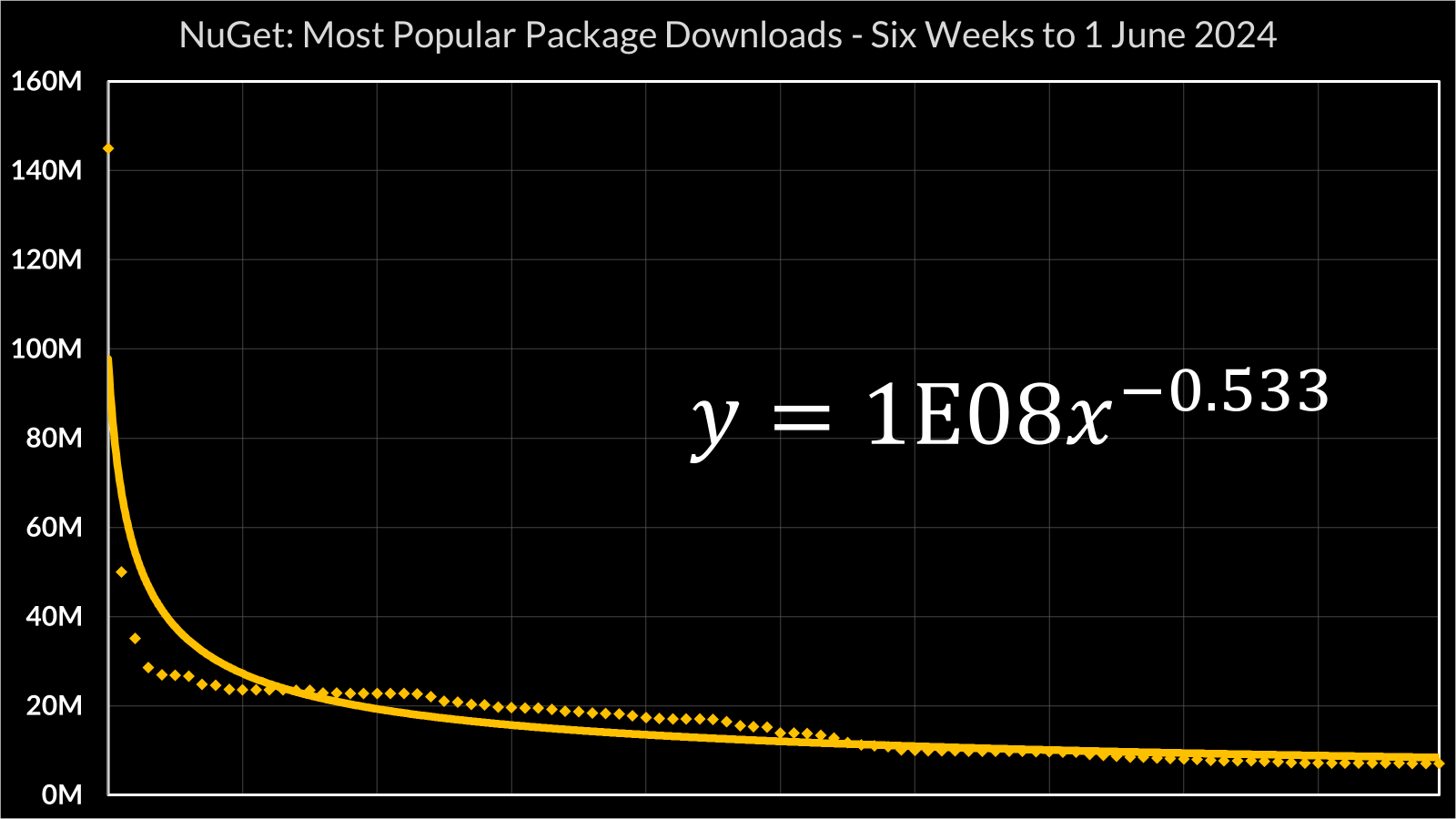Calculations and Statistics
In the talk that accompanies this website, I come up with some hypothetical numbers for how much open source project maintainers might get paid if there was a package repository which used a similar revenue model to streaming services like Spotify.
Here’s how I got the numbers, so you can check the arithmetic, and play around with your own inputs.
Total Download Figures
I based all this figures available at https://www.nuget.org/stats.
NuGet doesn’t publish total download figures, but at they do publish the top 100 community packages over the last 6 weeks.
I copied this data into this Excel spreadsheet, plotted it as a scatter graph, and added a power trend line:

Integrating that curve should give a reasonable estimate for the total number of downloads in that period. At the time of writing, nuget.org’s homepage claims 7,397,236 versions of 404,574 unique packages. The download charts are per package, not per version, so to estimate the total number of downloads, we need to integrate y = 1E8x^-0.533 between 1 and 404,574.
Plugging that into Wolfram Alpha gives us 88,736,900,000. Just under 89 billion.
As a sanity check: integrating that curve between 1 and 100 gives us 1,625,300,000, and the sum of the figures in the top 100 data set is 1,671,910,909, which gives us an error margin of ±3%, which is close enough for what I’m trying to do here.
Unique NuGet Users
This one’s the fudgiest step of the whole process. I added up the total number of downloads of Newtonsoft.Json, the most popular package on NuGet, in the last six weeks.
That’s 145,018,735 downloads in six weeks, or 145,018,735/6 = 24,169,789 downloads per week. Then, in the absence of any better data, I estimated the average NuGet user downloads Newtonsoft.Json ten times a week, giving 2.4 million active users.
Finding the Active Packages
I wanted to find out how many of the 404,574+ packages on NuGet are actually actively maintained. This one was a little trickier: NuGet doesn’t publish that data on the web, but it is available via the NuGet API… only problem is, that’s a huge dataset. The NuGet API exposes a resource called the catalog, an append-only data set that shows the full history of packages added to, modified and deleted from nuget.org.
I wrote a .NET console app that retrieves entries from the NuGet catalog and loads them into a local SQL database - you can find the whole thing on GitHub, or in NugetCat.zip
Data table definition:
-- SQL schema definition for Packages database
CREATE DATABASE [Packages]
GO
USE [Packages]
GO
CREATE TABLE [dbo].[Packages](
[Id] [nvarchar](2048) NOT NULL,
[CommitId] [uniqueidentifier] NOT NULL,
[PackageId] [nvarchar](1024) NOT NULL,
[PackageVersion] [nvarchar](1024) NOT NULL,
[CommitTimestamp] [datetimeoffset](7) NULL,
[Type] [varchar](64) NOT NULL
) ON [PRIMARY]
GO
The actual program uses SQL Bulk Copy and Marc Gravell’s excellent FastMember package to “throw data into a database as fast as humanly possible”; on my PC it took 739681ms - about 12 minutes - to import all 13,140,797 events currently in the catalog.
// NugetCat/Program.cs
using Newtonsoft.Json;
using System.Data.SqlClient;
using FastMember;
using System.Diagnostics;
const string SQL_CONNECTION_STRING
= @"Server=localhost;User ID=sa;Password=p@ssw0rd;"
+ "Database=Packages;MultipleActiveResultSets=True;";
const string LOCAL_CACHE_FOLDER = @"E:\pages\";
var sw = new Stopwatch();
sw.Start();
var http = new HttpClient();
var catalogUrl = "https://api.nuget.org/v3/catalog0/index.json";
var catalogJson = await http.GetStringAsync(catalogUrl);
var catalog = JsonConvert.DeserializeObject<Catalog>(catalogJson)!;
var conn = new SqlConnection(SQL_CONNECTION_STRING);
conn.Open();
var count = 0;
var po = new ParallelOptions { MaxDegreeOfParallelism = 32 };
var threshold = new DateTimeOffset(2023, 1, 1, 0, 0, 0, TimeSpan.Zero);
var pages = catalog.Items;
Console.WriteLine($"Fetching metadata for {pages.Sum(p => p.Count)} package events");
using var bcp = new SqlBulkCopy(conn);
bcp.DestinationTableName = "Packages";
string[] columns = [ "Id", "CommitId", "PackageId",
"PackageVersion", "CommitTimestamp", "Type" ];
foreach (var item in pages) {
var cachedPageFile = Path.Combine(LOCAL_CACHE_FOLDER, item.Id.Split('/').Last());
if (!File.Exists(cachedPageFile)) {
File.WriteAllText(cachedPageFile, await http.GetStringAsync(item.Id));
}
var pageJson = await File.ReadAllTextAsync(cachedPageFile);
var page = JsonConvert.DeserializeObject<Page>(pageJson)!;
using (var reader
= ObjectReader.Create(page.Items, columns)) {
try {
bcp.WriteToServer(reader);
} catch(SqlException ex) {
Console.WriteLine(ex.Message);
Console.WriteLine(cachedPageFile);
}
}
Interlocked.Add(ref count, page.Items.Count);
Console.WriteLine($"Inserted {count} package events");
}
Console.WriteLine($"Completed in {sw.ElapsedMilliseconds}ms");
With the data imported, I could query the catalog for packages which had at least one release in the last 12 months, and which had never been deleted:
SELECT
PackageId,
MAX(CommitTimestamp) as MostRecentEntry,
COUNT(*) as Releases
FROM Packages
WHERE CommitTimestamp > '2023-06-01'
and Type = 'nuget:PackageDetails'
and PackageId NOT IN (
SELECT PackageId
FROM Packages
WHERE Type = 'nuget:PackageDelete'
)
GROUP BY PackageId
That gave me 138,843 unique packages which have had a release/update since 1st June 2023.
In case you’re curious: the most active packages on NuGet are four packages which are part of Octopus Server (1, 2, 3, 4), all of which had 5,916 releases when I wrote this - an average of 16 releases per day. At the other extreme, there’s over 34,000 packages which have only had a single release in the last twelve months.
Anyway. That’s where I got the numbers that I used in the revenue model I go through in the talk: 138,843 active packages, and 2.4 million active users.
Plugging that 138,843 into the Wolfram Alpha integral gives an estimate of 53,767,000,000 total downloads in the last six weeks.